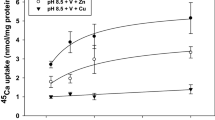Abstract
Cell pH (pHi) and cell membrane potential (V b) were measured in isolated S3 segments of rabbit renal proximal tubule with double-barrelled microelectrodes to search for a possible effect of the carbonic anhydrase inhibitor, acetazolamide (ACZ), on Cl−/HCO −3 exchange in the basolateral cell membrane. ACZ was found to retard and reduce the pHi response to bath Cl− removal reversibly with half-maximal inhibition at 0.42 mmol/l and a rather flat concentration dependence (Hill coefficient ≈ 0.36). To determine whether the retardation resulted from inhibition of cytoplasmic carbonic anhydrase, which might have delayed the attainment of HCO −3 /CO2 equilibrium, we have measured the response of pHi to step changes in PCO2 in the presence and absence of ACZ. ACZ greatly retarded the pHi response to CO2 steps; however, the concentration dependence differed (half-maximal inhibition at 18 μmol/l) and even at maximal ACZ concentrations the response to CO2 steps was more than twice as fast as the response to Cl− replacement. Since, in addition, the ACZ inhibition of Cl−/HCO −3 exchange could not be overcome by increasing PCO2 we conclude that the ACZ effect on Cl−/HCO −3 exchange in rabbit proximal tubule S3 segments does not result from inhibition of cytosolic or membrane-bound carbonic anhydrase, but from a direct interaction with the exchanger molecule.
Similar content being viewed by others
References
Burg G, Grantham J, Abramow M, Orloff J (1966) Preparation and study of fragments of single rabbit nephrons. Am J Physiol 210:1293–1298
Cousin JL, Motais R (1976) The role of carbonic anhydrase inhibitors on anion permeability into red blood cells. J Physiol (Lond) 256:61–80
Dobyan DC, Magill LS, Friedman PA, Hebert SC, Bulger RE (1982) Carbonic anhydrase histochemistry in rabbit and mouse kidneys. Anat Rec 204:185–197
Garg LC, Maren TH (1972) The rates of hydration of carbon dioxide and dehydration of carbonic acid at 37°C. Biochim Biophys Acta 261:70–76
Gray BA (1971) The rate of approach to equilibrium in uncatalyzed CO2 hydration reactions: the theoretical effect of buffering capacity. Respir Physiol 11:223–234
Kondo Y, Frömter E (1987) Axial heterogeneity of sodium-bicarbonate cotransport in proximal straight tubule of rabbit kidney. Pflügers Arch 410:481–486
Kondo Y, Frömter E (1990) Evidence for chloride/bicarbonate exchange mediating bicarbonate efflux from S3 segments of rabbit renal proximal tubule. Pflügers Arch 415:726–733
Kurtz I (1989) Basolateral membrane Na+/H+ antiport, Na+/base cotransport, and Na+-independent Cl−/base exchange in the rabbit S3 proximal tubule. J Clin Invest 83:616–622
Lönnerholm G, Ridderstrale Y (1980) Intracellular distribution of carbonic anhydrase in the rat kidney. Kidney Int 17:162–174
Maren TH (1969) Renal carbonic anhydrase and the pharmacology of sulfonamide inhibitors. In: Herken H (ed) Heffter's Handbook of Experimental Pharmacology, vol 24. Springer, New York Berlin Heidelberg, pp 195–256
McKinley DN, Whitney PL (1976) Particulate carbonic anhydrase in homogenates of human kidney. Biochim Biophys Acta 445: 780–790
Nakhoul NL, Chen LK, Boron WF (1990) Intracellular pH regulation in rabbit S3 proximal tubule: basolateral Cl-HCO3 exchange and Na-HCO3 cotransport. Am J Physiol 258:F371-F381
Passow H (1986) Molecular aspects of band 3 protein-mediated anion transport across the red cell membrane. Rev Physiol Biochem Pharmacol 103:62–223
Rector FC, Carter NW, Seldin DW (1965) The mechanism of bicarbonate reabsorption in the proximal and distal tubules of the kidney. J Clin Invest 44:278–290
Sanyal G, Pessah NI, Maren TH (1981) Kinetics and inhibition of membrane-bound carbonic anhydrase from canine renal cortex. Biochim Biophys Acta 657:128–137
Seki G, Frömter E (1990) The chloride/base exchanger in the basolateral cell membrane of rabbit renal proximal tubule S3 segment requires bicarbonate to operate. Pflügers Arch 417:37–41
Ullrich KJ, Rumrich G, Klöss S, Lang HJ (1985) Contraluminal sulfate transport in the proximal tubule of the rat kidney: V. Specificity: phenolphthaleins, sulfonphthaleins, and other sulfo dyes, sulfamoyl-compounds and diphenylamine-2-carboxy-lates. Pflügers Arch 404:311–318
Vieira FL, Malnic G (1968) Hydrogen ion secretion by rat renal cortical tubules as studied by an antimony microelectrode. Am J Physiol 214:710–718
Wistrand PJ, Kinne R (1977) Carbonic anhydrase activity of isolated brush border and basal-lateral membrane of renal tubular cells. Pflügers Arch 370:121–126
Author information
Authors and Affiliations
Rights and permissions
About this article
Cite this article
Seki, G., Frömter, E. Acetazolamide inhibition of basolateral Cl−/HCO −3 exchange in rabbit renal proximal tubule S3 segment. Pflugers Arch. 422, 55–59 (1992). https://doi.org/10.1007/BF00381513
Received:
Revised:
Accepted:
Issue Date:
DOI: https://doi.org/10.1007/BF00381513




